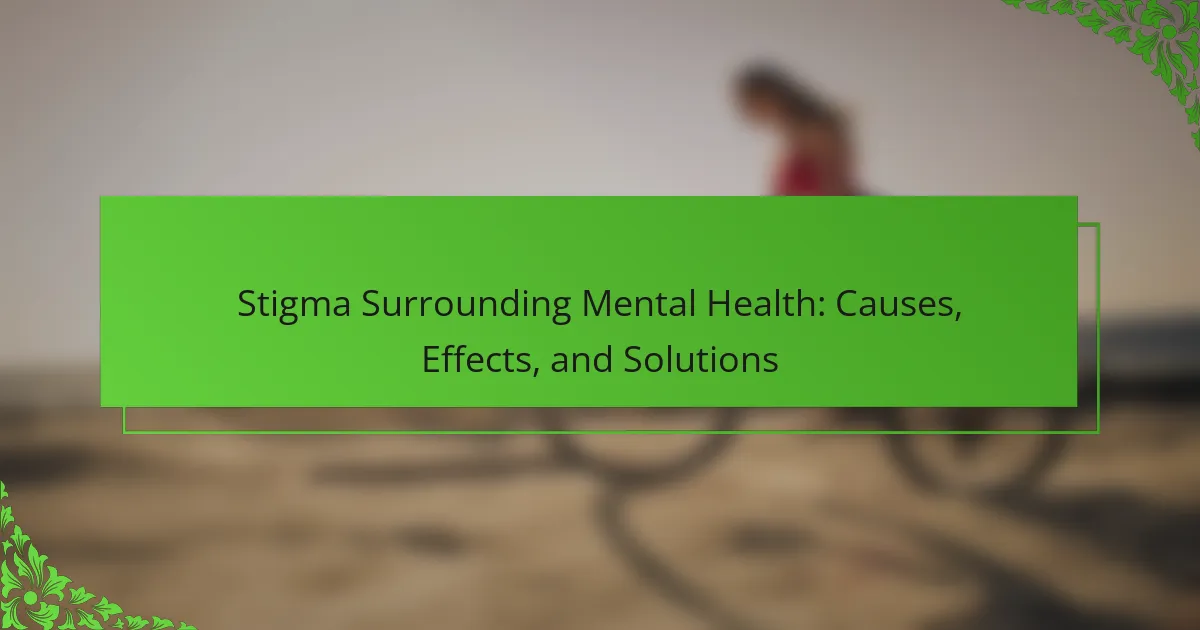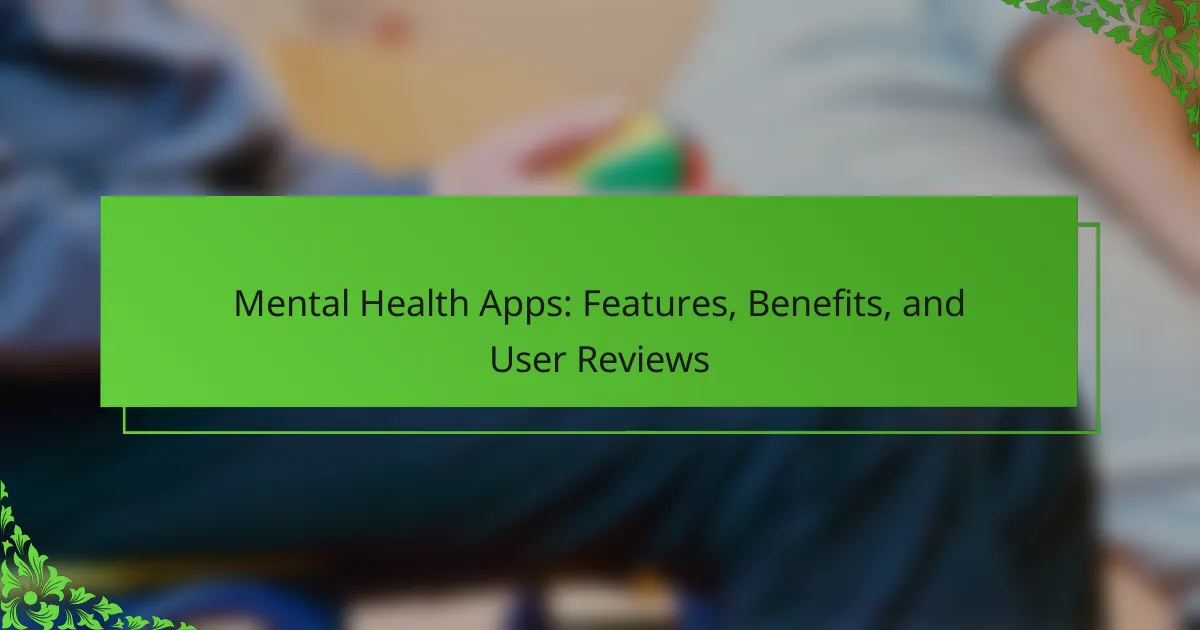The stigma surrounding mental health creates significant barriers for individuals seeking help. This article explores the causes of stigma, its detrimental effects on individuals and communities, and effective solutions to promote understanding and acceptance. Key strategies include education, open conversations, and community support initiatives. Additionally, it highlights the unique challenges faced by marginalized groups in addressing mental health stigma.
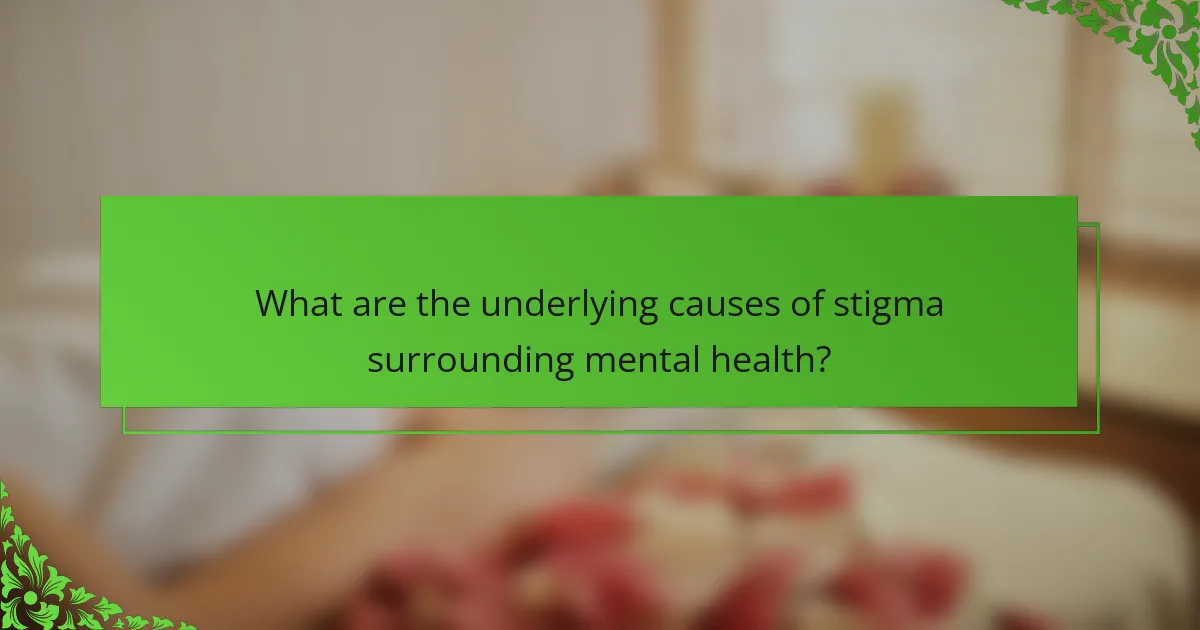
What are the underlying causes of stigma surrounding mental health?
The stigma surrounding mental health arises from misinformation, cultural beliefs, and fear of the unknown. Misunderstandings about mental health conditions lead to negative stereotypes. Cultural norms often prioritize emotional restraint, discouraging open discussions about mental well-being. Additionally, fear of judgment prevents individuals from seeking help, perpetuating isolation. These factors create a cycle that hinders progress in mental health awareness and acceptance.
How do cultural perceptions influence mental health stigma?
Cultural perceptions significantly shape mental health stigma by influencing beliefs and attitudes. In many cultures, mental health issues are seen as a weakness, leading to discrimination. For instance, societies that prioritize individualism may foster greater stigma compared to collectivist cultures that emphasize community support. This stigma can deter individuals from seeking help, exacerbating mental health conditions. Addressing these perceptions through education and awareness can reduce stigma and promote mental well-being.
What role do media representations play in shaping stigma?
Media representations significantly influence stigma surrounding mental health by shaping public perceptions and attitudes. Negative portrayals in films and news can reinforce harmful stereotypes, leading to increased discrimination. Research indicates that individuals exposed to stigmatizing media are more likely to hold prejudiced views towards those with mental health issues. Conversely, positive representations can promote understanding and empathy, reducing stigma. For example, campaigns featuring real stories of recovery can challenge misconceptions and encourage supportive behaviors.
How does lack of education contribute to mental health misconceptions?
Lack of education significantly contributes to mental health misconceptions by fostering ignorance and misinformation. Individuals with limited education often lack access to accurate information about mental health conditions, leading to stereotypes and stigma. For instance, studies show that higher education levels correlate with better understanding and acceptance of mental health issues. As a result, misconceptions persist, causing individuals to avoid seeking help. Addressing educational gaps can improve awareness and reduce stigma surrounding mental health.
Which societal norms perpetuate stigma against mental health issues?
Societal norms such as stigma, lack of understanding, and cultural beliefs perpetuate discrimination against mental health issues. Negative stereotypes often associate mental illness with weakness, leading to social isolation. Additionally, traditional views on mental health discourage open discussions, further entrenching stigma. Education and awareness can counteract these harmful norms, fostering a more supportive environment for those affected.
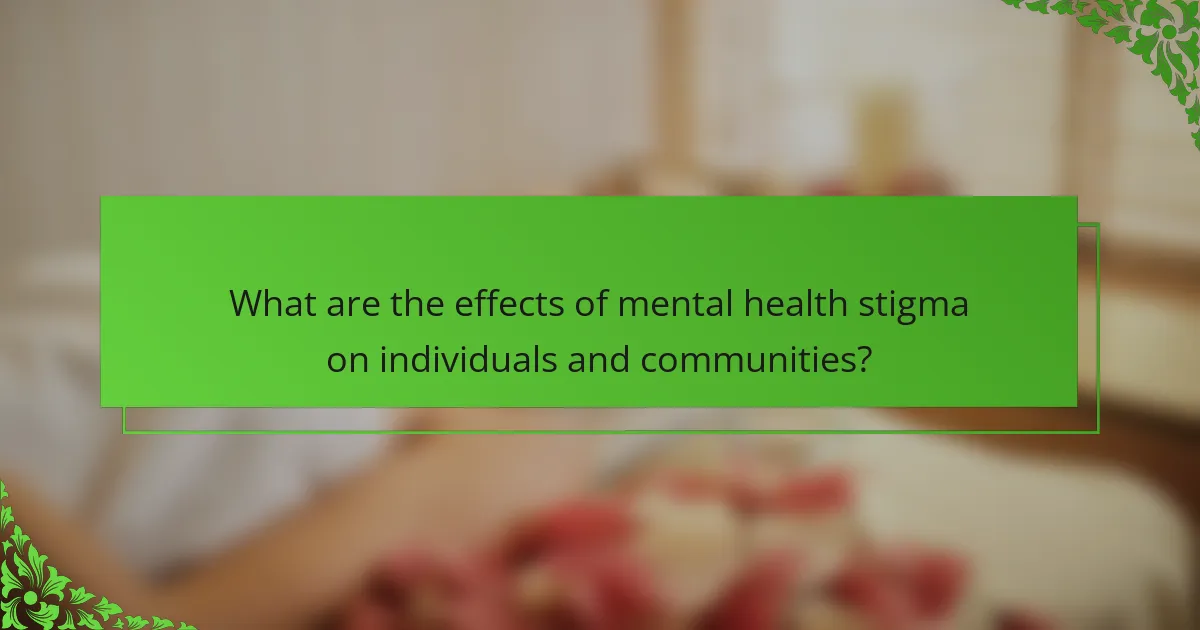
What are the effects of mental health stigma on individuals and communities?
Mental health stigma negatively impacts individuals and communities by fostering discrimination and isolation. This stigma often leads to reduced access to mental health services, as individuals fear judgment. As a result, many people avoid seeking help, worsening their conditions. Communities suffer from decreased overall well-being and increased healthcare costs due to untreated mental health issues. Additionally, stigma can perpetuate negative stereotypes, further alienating those affected. Addressing mental health stigma requires education and advocacy to promote understanding and acceptance.
How does stigma impact help-seeking behavior among individuals?
Stigma significantly hinders help-seeking behavior among individuals facing mental health challenges. Fear of judgment and discrimination leads to avoidance of necessary support. Research indicates that 60% of individuals with mental health issues do not seek help due to stigma. This reluctance can exacerbate symptoms and prolong suffering. Addressing stigma through education and awareness is crucial for encouraging individuals to seek the help they need.
What are the psychological effects of stigma on mental health patients?
Stigma negatively impacts mental health patients by exacerbating feelings of shame and isolation. It can lead to decreased self-esteem and increased anxiety, making it harder for individuals to seek help. Research indicates that stigma may prevent 60% of those with mental health issues from accessing necessary care. Additionally, social stigma can foster discrimination in workplaces and communities, further hindering recovery. Addressing stigma through education and awareness can improve mental health outcomes and encourage open discussions about mental health challenges.
How does stigma affect relationships and social interactions?
Stigma significantly hinders relationships and social interactions by fostering misunderstandings and fear. It often leads to isolation for those affected by mental health issues, limiting their social engagement. Stigmatized individuals may experience rejection from peers, which exacerbates feelings of loneliness and anxiety. As a result, open communication about mental health becomes challenging, further entrenching the stigma. Addressing stigma through education and awareness can improve social connections and support systems.
What are the broader societal implications of mental health stigma?
The stigma surrounding mental health has significant societal implications, affecting individuals and communities. It leads to discrimination, social isolation, and reduced access to care.
Stigmatization can deter individuals from seeking help, exacerbating mental health issues. For example, studies show that 60% of people with mental health conditions do not seek treatment due to fear of judgment.
Moreover, mental health stigma impacts workplace dynamics, resulting in decreased productivity and increased absenteeism. Organizations that foster an inclusive environment can mitigate these effects, promoting overall well-being.
Addressing mental health stigma requires comprehensive education and awareness campaigns. Such initiatives can help reshape societal perceptions, encouraging open conversations and support for those affected.
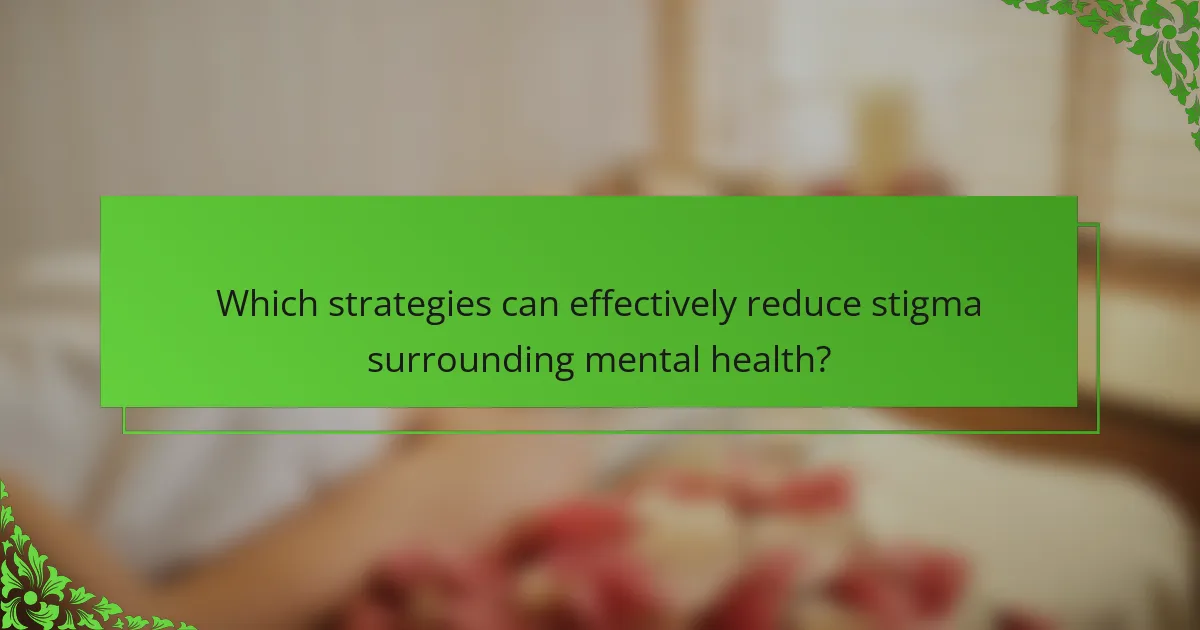
Which strategies can effectively reduce stigma surrounding mental health?
Effective strategies to reduce stigma surrounding mental health include education, open conversations, and community support initiatives. Education dispels myths and promotes understanding, while open conversations encourage sharing experiences. Community support initiatives create safe spaces for individuals to seek help without fear.
1. Implement educational programs in schools and workplaces to increase awareness.
2. Encourage storytelling through personal experiences to humanize mental health issues.
3. Foster supportive environments where individuals feel safe discussing their struggles.
4. Collaborate with mental health organizations to promote awareness campaigns.
5. Train professionals to handle mental health topics sensitively and effectively.
How can education and awareness campaigns mitigate stigma?
Education and awareness campaigns can significantly reduce stigma surrounding mental health. By providing accurate information, these initiatives challenge misconceptions and promote understanding.
Effective campaigns often utilize real-life stories to humanize mental health issues, fostering empathy. For instance, community workshops can create safe spaces for discussions, further normalizing mental health conversations. Research indicates that informed communities show a 30% decrease in stigma-related attitudes.
Additionally, integrating mental health education into school curricula cultivates early awareness, shaping future generations’ perceptions. As a result, these efforts contribute to a more supportive environment for individuals facing mental health challenges.
What role do support groups play in combating stigma?
Support groups play a crucial role in combating stigma surrounding mental health by providing a safe space for individuals to share experiences. They promote understanding and acceptance, reducing feelings of isolation. Members often learn coping strategies and gain confidence in discussing their mental health. Research shows that participation in support groups can lead to improved mental well-being and decreased stigma within communities.
How can mental health professionals address stigma in their practices?
Mental health professionals can address stigma by fostering open conversations, educating clients and communities, and promoting inclusivity. They should create safe environments where individuals feel comfortable discussing mental health issues. Training staff on stigma reduction techniques is essential. Collaborating with advocacy groups can amplify efforts and reach broader audiences.
What initiatives have been successful in reducing stigma in specific communities?
Successful initiatives in reducing stigma around mental health include community awareness programs, peer support networks, and educational campaigns. These efforts foster understanding and acceptance, leading to decreased discrimination. For example, mental health first aid training equips individuals with skills to support those in distress, enhancing community resilience. Additionally, storytelling initiatives encourage individuals to share their experiences, normalizing mental health discussions.
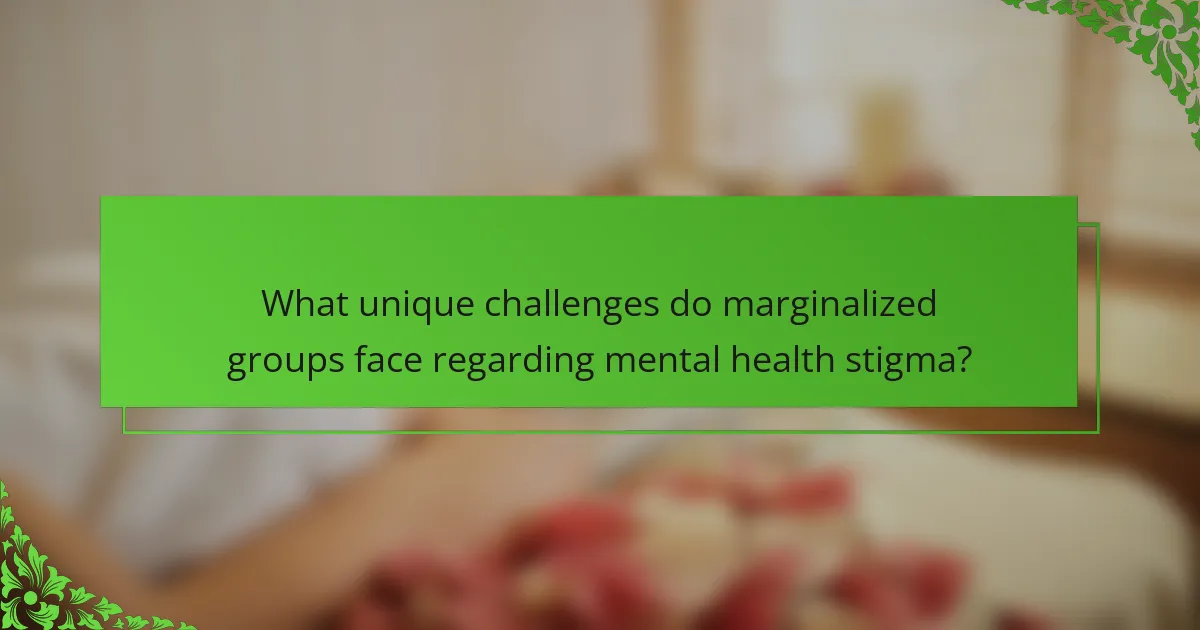
What unique challenges do marginalized groups face regarding mental health stigma?
Marginalized groups face unique challenges regarding mental health stigma that exacerbate their struggles. These challenges include cultural misconceptions, limited access to mental health resources, and fear of discrimination. For example, individuals from minority ethnic backgrounds may encounter stereotypes that discourage them from seeking help. Additionally, socioeconomic factors can limit access to mental health services, further isolating these groups. As a result, the stigma surrounding mental health can lead to increased feelings of shame and reluctance to engage in treatment. Addressing these issues requires targeted awareness campaigns and culturally competent care.
How does stigma differ for various demographic groups?
Stigma surrounding mental health varies significantly among demographic groups due to cultural, social, and economic factors. For instance, marginalized communities often face heightened stigma due to lack of representation and support. In contrast, more privileged groups might experience stigma differently, often related to perceptions of vulnerability. Research indicates that racial and ethnic minorities may internalize stigma, affecting their willingness to seek help. Additionally, age and gender can influence stigma perceptions, with younger individuals often more open to discussing mental health than older generations. Addressing these disparities is crucial for effective mental health interventions.
What are the specific barriers faced by minority populations in accessing mental health care?
Minority populations face significant barriers in accessing mental health care, primarily due to stigma. This stigma stems from cultural beliefs, fear of discrimination, and lack of understanding about mental health issues. As a result, individuals may avoid seeking help, leading to untreated conditions and worsening mental health outcomes. Additionally, systemic inequalities, such as limited access to resources and culturally insensitive care, further exacerbate these challenges. Addressing stigma through education and community outreach can improve access and encourage individuals to seek necessary support.
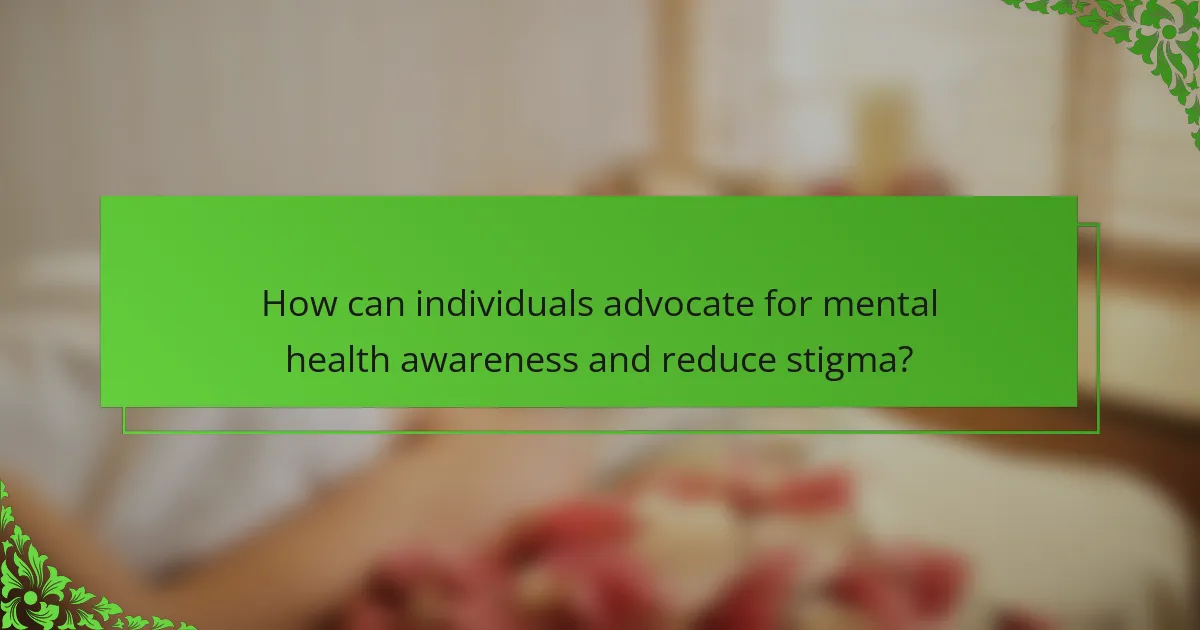
How can individuals advocate for mental health awareness and reduce stigma?
Individuals can advocate for mental health awareness and reduce stigma by engaging in open conversations, educating themselves and others, and supporting mental health initiatives. Sharing personal stories can humanize the issue and foster understanding.
Joining or forming community groups focused on mental health can amplify voices and promote awareness. Additionally, utilizing social media platforms to spread positive messages and share resources can reach a broader audience.
Advocacy efforts should emphasize the importance of mental health education in schools and workplaces to create supportive environments. Collaborating with mental health organizations can enhance outreach and effectiveness.
Ultimately, consistent and compassionate dialogue is essential for dismantling stigma and encouraging individuals to seek help.
What personal actions can promote understanding and empathy?
Personal actions that promote understanding and empathy include active listening, educating oneself about mental health, and sharing personal experiences. Engaging in open conversations can reduce stigma and foster connections. Volunteering for mental health organizations enhances awareness and support. Practicing kindness and compassion in daily interactions builds a more empathetic community.
How can social media be leveraged to challenge stigma?
Social media can effectively challenge mental health stigma by fostering open conversations and sharing personal stories. Platforms allow individuals to connect, educate others, and promote awareness. For example, campaigns using hashtags can unify voices and create supportive communities. As a result, this visibility can reduce misconceptions and encourage acceptance.
What are the best practices for discussing mental health openly?
Open discussions about mental health can reduce stigma and promote understanding. Best practices include fostering a safe environment, using inclusive language, sharing personal experiences, and encouraging active listening. These approaches help create supportive dialogues that can lead to greater awareness and empathy.
What common mistakes should be avoided when addressing mental health stigma?
To effectively address mental health stigma, avoid these common mistakes. Failing to educate yourself on mental health issues perpetuates misinformation. Using derogatory language reinforces negative perceptions. Dismissing personal experiences invalidates feelings and discourages open dialogue. Lastly, neglecting to challenge stereotypes allows stigma to persist.
